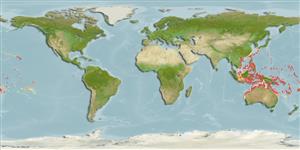Environment: milieu / climate zone / depth range / distribution range
Ecología
marino asociado a arrecife; rango de profundidad 0 - 30 m (Ref. 128797). Tropical; 35°N - 29°S, 105°E - 137°W
Pacific Ocean: Indonesia to the Society Islands, north to southern Japan, south to Rowley Shoals and New Caledonia; throughout Micronesia. Reported from Christmas Island in the eastern Indian Ocean (Ref. 5439). Replaced by Heniochus pleurotaenia in the Indian Ocean (Ref. 37816).
Tamaño / Peso / Age
Maturity: Lm ? range ? - ? cm
Max length : 19.0 cm TL macho / no sexado; (Ref. 9710)
Espinas dorsales (total): 11; Radios blandos dorsales (total): 22-25; Espinas anales 3; Radios blandos anales: 17 - 18. This species is distinguished by the following characters: adults with a pair of prominent horns on the forehead, just above the eyes and a distinct protuberance on forehead; snout length 2.9-3.5 in HL; greatest body depth 1.3-1.5 in SL. Colour solid brown to blackish triangular area between white bands (2 white bands running from caudal peduncle and breast to each end of spinous section of dorsal fin) (Ref. 90102).
Occur in deep lagoons and steep outer reef slopes, with mixed algae and coral growth (Ref. 48636). Solitary or in small groups. Feed on corals and other invertebrates (Ref. 9710). Oviparous (Ref. 205). Form pairs during breeding (Ref. 205). Maximum depth reported taken from Ref. 48636.
Life cycle and mating behavior
Madurez | Reproducción | Puesta | Huevos | Fecundidad | Larva
Form pairs during breeding (Ref. 205).
Myers, R.F., 1991. Micronesian reef fishes. Second Ed. Coral Graphics, Barrigada, Guam. 298 p. (Ref. 1602)
IUCN Red List Status (Ref. 130435)
Threat to humans
Harmless
Human uses
Pesquerías: escaso valor comercial; Acuario: Comercial
Más información
ReferenciasAcuiculturaPerfil de acuiculturaRazasGenéticaElectrophoresesheritabilidadEnfermedadesProcesamientoNutrientsMass conversion
Herramientas
Warning: mysqli::__construct(): (HY000/1040): Too many connections in /var/www/html/includes/speciessummary.lib.php on line 2414
Can't connect to MySQL database fbquizv2. Errorcode: Too many connections
